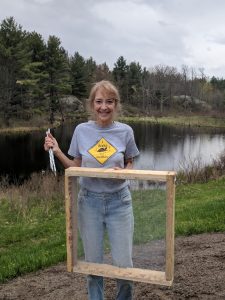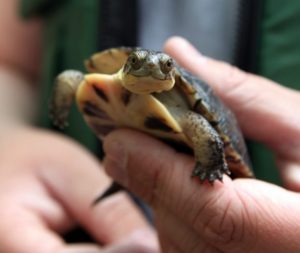
Denice Wilkins holding a ICU, Photo by Connor Robinson, QNet News
By Connor Robinson [1]
BELLEVILLE – As a lifelong conservationist, Denice Wilkins has been helping Ontario’s native turtle population for the past several years.
From late May to early July is turtle nesting season in Ontario and with all eight native species in decline, there are several options for people to help save turtles from predators and getting run over by cars.
One of the options is the Incubation Care Unit. The ICU is a wooden square, with one side consisting of wire mesh and the other side being open. The ICU is placed on the ground, with the open side down. When the ICU is in place, two of the four side walls have doorways so the hatchlings can leave after hatching.

Photo of a Blanding Turtle, a species native to Ontario, Photo by Wikimedia
“The females leave. They don’t stay and protect the nest,” says Denice Wilkins [2] who makes the ICUs herself and coined the term. She is the environmental officer who is also responsible for marketing for the Quinte Field Naturalists.
“Turtles are site loyal, and if they nested on your property last year, they will nest on your property this year, perhaps even in the exact same spot.”
Wilkins builds around 25 to 50 ICUs a season and sells them all. She says she isn’t sure how many she has built over the years or even how many years she has been building them.
With natural predators such as raccoons, skunks and foxes, the turtle eggs are especially vulnerable right after they are laid, because the scent is strongest then. Right after the turtle leaves the eggs, the ICU goes to work, protecting the eggs with its wooden and metal mesh structure while being held into the ground by iron pegs.
After 60 to 90 days, the eggs hatch and the turtles head for the nearest water. A new hatched turtle is almost as vulnerable as a turtle in a egg, so its important to help them even after hatching. This can be done by moving them to the water’s edge not too far away from where they were born.
It will take 200 eggs and up to 25 years to replace a single female turtle that is killed, so it is now as important as ever to help preserve Ontario’s turtle population.
If you find an injured turtle, call The Ontario Turtle Conservation Centre [3] (705-741-5000) or Sandy Pines Wildlife Centre [4] (613-354-0264).